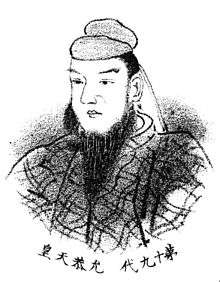Emperor Ingyō
| Ingyō | |
|---|---|
 | |
| Emperor of Japan | |
| Reign | 412–453 (traditional)[1] |
| Predecessor | Hanzei |
| Successor | Ankō |
| Born | 376 |
| Died | 453 (aged 76–77) |
| Burial | Ega no Naganu no kita no misasagi (Osaka) |
| Spouse |
|
| Issue | See below |
| House | Yamato |
| Father | Emperor Nintoku |
| Mother | Princess Iwanohime |
Emperor Ingyō (允恭天皇 Ingyō-tennō) was the 19th emperor of Japan,[2] according to the traditional order of succession.[3]
No firm dates can be assigned to this emperor's life or reign, but he is conventionally considered to have reigned from 410 to 453.[4]
Legendary narrative
Ingyō is regarded by historians as a "legendary emperor" of the 5th century.[5] The reign of Emperor Kinmei (c. 509 – 571 AD), the 29th emperor,[6] is the first for which contemporary historiography is able to assign verifiable dates;[7] however, the conventionally accepted names and dates of the early emperors were not to be confirmed as "traditional" until the reign of Emperor Kanmu (737–806), the 50th sovereign of the Yamato dynasty.[8]
According to Kojiki and Nihon Shoki, he was the fourth son of Emperor Nintoku and his consort Iwanohime, and therefore a younger brother of his predecessor Emperor Hanzei. He sat on the throne after Hanzei died and ruled for 41 years.
Ingyō's contemporary title would not have been tennō, as most historians believe this title was not introduced until the reigns of Emperor Tenmu and Empress Jitō. Rather, it was presumably Sumeramikoto or Amenoshita Shiroshimesu Ōkimi (治天下大王), meaning "the great king who rules all under heaven". Alternatively, Ingyō might have been referred to as (ヤマト大王/大君) or the "Great King of Yamato".
His consort was Oshisaka no Ōnakatsu no Hime. They had five sons and four daughters, including Emperor Ankō and Emperor Yūryaku. He reformed the system of family and clan names, because many named themselves false names using higher ranked clan or family names.
Events of Ingyō's reign
The earliest documented earthquake in Japan occurred during Ingyō's reign, in 416, when the Imperial Palace at Kyoto was leveled by the severity of the Earth's tremors.[9]
Some scholars identify Ingyō with King Sai in the Book of Song. This would have been a king of Japan (referred to as Wa by contemporary Chinese scholars) who is said to have sent messengers to the Liu Song dynasty at least twice, in 443 and 451.
According to Nihon Shoki, the king of the Korean Silla Kingdom grieved very much when Ingyō died. To comfort the soul of Ingyo, he presented Japan 80 musicians.[10]
The actual site of Ingyō's grave is not known.[2] This emperor is traditionally venerated at a memorial Shinto shrine near Osaka.
The Imperial Household Agency designates this location as Ingyō's mausoleum.[11] It is formally known as Emperor Ingyō's misasagi (恵我長野北陵, Ega no nagano no kita no misasagi), in Fujiidera city near Osaka.[12]
Consorts and children
Empress: Oshisaka no Ōnakatsuhime (忍坂大中姫), daughter of Wakanuke-Futamata no Miko (稚渟毛二派皇子)
- Prince Kinashi no Karu
- Princess Nagata no Ōiratsume (名形大娘皇女)
- Prince Sakai no Kurohiko (境黒彦皇子) (?–456)
- Prince Anaho (穴穂皇子) (Emperor Ankō) (401?–456)
- Princess Karu no Ōiratsume (軽大娘皇女)
- Prince Yatsuri no Shirahiko (八釣白彦皇子) (?–456)
- Prince Ōhatuse no Wakatakeru (大泊瀬稚武皇子) (Emperor Yūryaku) (418–479)
- Princess Tajima no Tachibana no Ōiratsume (但馬橘大娘皇女)
- Princess Sakami (酒見皇女)
Other consort: Sotoshi no Iratsume (衣通郎姫), younger sister of Oshisaka no Ōnakatsuhime
See also
Notes

- ↑ "Genealogy of the Emperors of Japan" at Kunaicho.go.jp; retrieved 2013-8-28.
- 1 2 Imperial Household Agency (Kunaichō): 允恭天皇 (19); retrieved 2013-8-28.
- ↑ Titsingh, Isaac. (1834). Annales des empereurs du japon, p. 26; Brown, Delmer M. (1979). Gukanshō, pp. 257–268; Varley, H. Paul. (1980). Jinnō Shōtōki, p. 112.
- ↑ Ponsonby-Fane, Richard. (1959). The Imperial House of Japan, p. 39.
- ↑ Kelly, Charles F. "Kofun Culture," Japanese Archaeology. 27 April 2009.
- ↑ Titsingh, pp. 34–36; Brown, pp. 261–262; Varley, pp. 123–124.
- ↑ Hoye, Timothy. (1999). Japanese Politics: Fixed and Floating Worlds, p. 78; excerpt, "According to legend, the first Japanese emperor was Jinmu. Along with the next 13 emperors, Jinmu is not considered an actual, historical figure. Historically verifiable Emperors of Japan date from the early sixth century with Kinmei.
- ↑ Aston, William. (1896). Nihongi, pp. 109.
- ↑ Hammer, Joshua. (2006). Yokohama Burning: The Deadly 1923 Earthquake and Fire that Helped Forge the Path to World War II, p. 62., p. 62, at Google Books
- ↑ Nihonshoki, Vol. 13, Story of Ingyō
- ↑ Ponsonby-Fane, p. 419.
- ↑ Gowland, William. "The Burial Mounds and Dolmens of the Early Emperors of Japan", The Journal of the Royal Anthropological Institute of Great Britain and Ireland, Vol. 37, January–June 1907, pp. 10–46.
References
- Aston, William George. (1896). Nihongi: Chronicles of Japan from the Earliest Times to A.D. 697. London: Kegan Paul, Trench, Trubner. OCLC 448337491
- Brown, Delmer M. and Ichirō Ishida, eds. (1979). Gukanshō: The Future and the Past. Berkeley: University of California Press. ISBN 978-0-520-03460-0; OCLC 251325323
- Hammer, Joshua. (2006). Yokohama Burning: The Deadly 1923 Earthquake and Fire that Helped Forge the Path to World War II. New York: Simon & Schuster. ISBN 978-0-7432-6465-5 (cloth)
- Ponsonby-Fane, Richard Arthur Brabazon. (1959). The Imperial House of Japan. Kyoto: Ponsonby Memorial Society. OCLC 194887
- Titsingh, Isaac. (1834). Nihon Ōdai Ichiran; ou, Annales des empereurs du Japon. Paris: Royal Asiatic Society, Oriental Translation Fund of Great Britain and Ireland. OCLC 5850691
- Varley, H. Paul. (1980). Jinnō Shōtōki: A Chronicle of Gods and Sovereigns. New York: Columbia University Press. ISBN 978-0-231-04940-5; OCLC 59145842
| Regnal titles | ||
|---|---|---|
| Preceded by Emperor Hanzei |
Emperor of Japan: Ingyō 412–453 (traditional dates) |
Succeeded by Emperor Ankō |